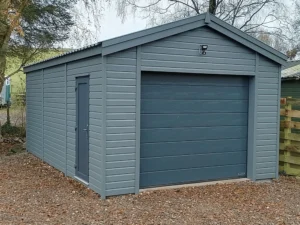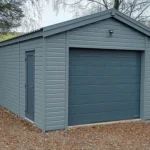Bathrooms used to be the most functional, most ignored space in a home. Now? They’re pulling serious design weight. With homeowners investing in spa-inspired upgrades, mood lighting, architectural tile, and vanity setups that rival the kitchen, bathrooms are stepping into the spotlight. And not just for luxury builds—this shift is playing out in older homes, condos, and modest remodels alike. A fresh generation of materials and tech is changing how people approach space. From layout to lighting to storage that doesn’t look like storage, today’s bathrooms are evolving fast—and the details matter more than ever.
Texture Is Doing the Heavy Lifting
Smooth, sleek bathrooms had their run, but design is heading in a warmer direction, literally and visually. Textured surfaces are bringing dimension back into the mix. Fluted vanities, reeded glass, and heavily veined stones are helping spaces feel layered and tactile. Even something as simple as switching to a matte tile or going with limewash paint on the walls can completely change the tone of the room. It’s not just about aesthetics either—people want spaces that feel lived-in and thoughtful, not like they were plucked from a showroom.
The tactile quality is especially noticeable in wall treatments. Designers are bringing in materials like tadelakt and microcement to add richness to the shell of the bathroom. When paired with curved forms—arched mirrors, round-edge countertops, softened lighting—the whole room gets a more inviting, cocoon-like feel. Texture is essentially replacing color as the defining element in many of these spaces. That doesn’t mean color is gone, but the days of everything being white-on-white are definitely fading.
The New Vanity Isn’t Just a Sink Cabinet
Bathroom vanities are evolving fast, and their design is taking cues from furniture, not kitchen cabinetry. Floating styles continue to dominate for their light profile and ease of cleaning underneath, but there’s a strong movement toward integrated pieces that feel custom-built—even if they’re not. Wood tones are showing up more, with natural finishes and horizontal grain offering a subtle break from all the tile and porcelain. Designers are also choosing hardware more intentionally, pairing unlacquered brass or matte black pulls with curved drawers and asymmetrical layouts to make the vanity feel like a centerpiece.
One of the most noticeable upgrades is the lighting. Instead of a single overhead fixture or traditional sconces, designers are using layered lighting around vanities to create a much softer, more functional glow. Think: integrated backlights behind mirrors, warm LEDs running beneath floating cabinetry, and pendants hung at face level. When done right, this kind of lighting not only makes the space look better, it changes how people feel using it. You’re not squinting at your reflection in the morning, and at night, the room winds down with you.
And yes, we’re still seeing a lot of double vanities—but not necessarily side by side anymore. Some homeowners are opting to split them entirely, placing two separate stations across from each other or even in corners. It’s a layout choice that offers more breathing room and makes modernizing your space feel like less of a squeeze.
Showers Are Taking Over, Literally
The freestanding tub had its moment, but more homeowners are skipping the soak altogether and putting that square footage to better use. Larger, walk-in showers are taking over—especially ones without doors or thresholds. These open designs feel clean, airy, and a bit indulgent, but they’re also easier to maintain. Linear drains, oversized slabs, and continuous floor tile make the whole space feel seamless and expansive, even when the footprint is small.
Glass is playing a more selective role. In some cases, it’s eliminated entirely, with just a strategic wall or half partition to keep things dry. In others, reeded or frosted finishes are being used for visual privacy without making the room feel boxed in. There’s also a rise in zoned showers—meaning separate controls for each showerhead or spray, with temperature and pressure adjusted individually. It’s a smart design that caters to real people with different preferences, not just aesthetics.
That said, when tubs are included, they’re treated as sculpture. Stone resin and cast concrete are becoming more common, with clean lines and organic shapes that feel high-end without being flashy. These tubs don’t look like something you grabbed on sale—they’re meant to anchor the space.
Storage Is No Longer an Afterthought
You used to see one of two storage solutions in bathrooms: a builder-grade medicine cabinet or nothing. That’s no longer cutting it. Designers are building out storage in smarter, better-looking ways that reflect how people actually live. Recessed nooks in showers for products. Tall, built-in towers for linens. Slim drawers hidden behind vanity fronts. There’s a stronger focus on storage that blends in, functions well, and doesn’t disrupt the design.
Lighting isn’t just about vanity zones either. Accent lighting inside drawers, under shelves, or around toe kicks is becoming standard in upscale bathrooms—and is quickly trickling down to everyday remodels. These touches might sound small, but they completely change the usability of the space, especially during nighttime routines.
Then there’s the rise of custom cabinets in Scottsdale, Boston, Richmond, honestly wherever you live. It’s not just a trend—it’s a full shift toward personalized storage solutions that feel made for the user. Instead of generic open shelving or bulky pre-fab units, designers are bringing in bespoke millwork tailored to the dimensions, style, and habits of the homeowner. Even in smaller bathrooms, this custom approach can solve problems while elevating the entire feel of the space.
Tech Is Quietly Running the Show
You won’t necessarily notice the tech in a well-designed modern bathroom, and that’s the point. Smart mirrors with defogging and dimming, heated floors with zoned control, integrated speakers hidden behind walls or ceilings—it’s all there, but it doesn’t scream for attention. The idea is convenience without complication. Tap-to-fill bathtubs, automatic lighting scenes, even digital shower controls that remember your ideal settings are becoming more common.
Toilets are getting smarter too, and it’s not just about bidets. Wall-hung toilets with hidden tanks are freeing up visual space, and many come with customizable flush settings, self-cleaning modes, and seat warming that doesn’t feel gimmicky. All of this is pushing the bathroom closer to the experience you’d get in a boutique hotel, only built around your own preferences and schedule.
The best examples of this tech are subtle and beautifully integrated. You’re not seeing clunky interfaces or obvious buttons. It’s all designed to make the space more comfortable and intuitive, not more complicated.
Why It All Matters
Bathroom design is no longer just about materials or colors. It’s about how the space works, how it feels, and how it supports the rhythm of daily life. The best bathrooms right now aren’t just stylish—they’re smart, personal, and surprisingly warm. They’ve finally caught up to the rest of the home. And in some ways, they’re quietly outpacing it.
Also Read-Creative Programs for Building Life Skills










